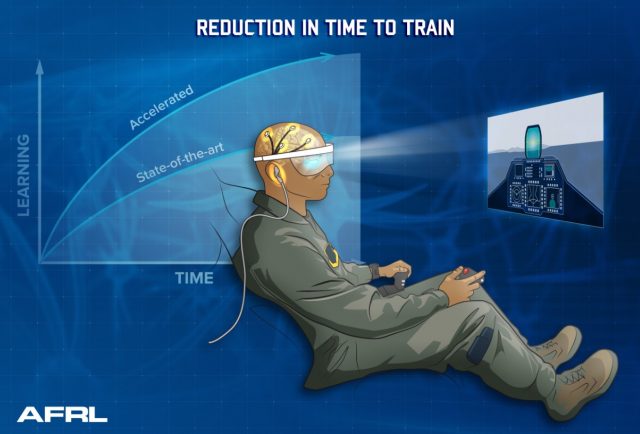The US Air Force is looking to develop a technology that would allow airmen to rapidly acquire knowledge and skills on the fly through direct brain interfaces with the help of neurotechnologies.
While the service admits the idea might sound like something straight out of a sci-fi movie, it said that it is actually more achievable than it sounds.
Called the Individualized Neural Learning System, or iNeuraLS, the technology is a new augmented learning platform that will enable rapid learning by closed-loop modulation of cognitive states during skill acquisition.
To gather data on brain activity, an Air Force Research Laboratory team will develop a hybrid brain-machine interface using a combination of two well-established, non-invasive technologies: electroencephalography, commonly known as EEG, and magnetoencephalography, or MEG. Each technology offers its own advantages. Part of the information generated by neuronal currents in the brain is represented as electric fields, which are picked up by EEG, while the other part is represented as magnetic fields, which is picked up by MEG. Additionally, MEG allows for a higher spatial resolution compared to EEG. Therefore, a hybrid of the two technologies would allow researchers to gather information on brain activity quickly, and pinpoint exactly where the activity is occurring within the brain. The researchers will gather this data while a human subject is under different stages of learning and different variables such as fatigue, attention and memory.
“It may sound like science fiction, but it is rooted in science. Over the last decade we have made tremendous progress in our understanding of brain function related to airman performance and have also developed and tested a toolkit of neuromodulation technologies to drive the brain to an optimal performance state,” Dr. Gaurav Sharma, senior technical lead for Cognitive Neuroscience at AFRL, said.
“With iNeuraLS, we are taking it to the next level by creating an immersive closed-loop system that will be optimized to each user’s learning potential.”
“We’re going to have unprecedented access to the brain using a novel brain-machine interface,” said Dr. Nathaniel Bridges, AFRL research biomedical engineer and Neural Interface team lead. He added that these neural signals will be used to develop algorithms that will help researchers determine the optimal brain state under which individuals can receive information. From there, the team will determine the most effective means of enhancing the subjects’ ability to intake and process information. This could range from non-invasive neuromodulation—or brain stimulation—techniques to the use of augmented reality to alter perceived environmental conditions.
At the culmination of the three-year effort, the team will demonstrate the technology through a use-case scenario, which may look something like a flight simulator task, to show the ability of the system to accelerate a user’s ability to acquire skills to complete the task.
Bridges said this research could ultimately prove beneficial in training air force pilots more quickly. Although the applications of this research are specifically focused toward the air force mission, he said the project will contribute to a body of knowledge that could indirectly benefit the entire neuroscience community. He also hopes that other military organizations such as the Space Force as well as the maintenance and aeromedical communities might benefit from and build upon the technology.
“We are very excited to embark on this research and see where we can take it,” Bridges said. “This is a project with tremendous potential for the military and neuroscientific community. It is truly art inspiring science.”



























